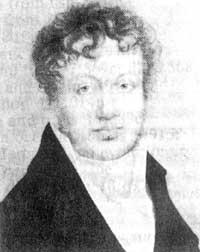Andre-Marie Ampere
Elhuyar Fundazioa
This physicist and mathematician first saw in Lyon the light of this world on 22 January 1775. His father was a retired merchant who was killed by guilotine during the French revolution when the Republicans took over the city in 1793. Andre-Marie then suffered a great depression.
Since childhood he tried to learn on his own literature, natural sciences, philosophy, mathematics, etc. He had great mathematical ease and by the age of thirteen he had written a treatise on conical cuts.
In 1801 he was appointed professor of Bourg to teach physics and chemistry. In 1802, using probability calculation, he published a work on game theory.
In 1804 his wife, newly married, died. He had to suffer a new depression.

However, he continued to teach physics and chemistry in Bourg and in 1809 he taught mathematics at the Polytechnic School of Paris. In 1814 he was appointed member of the Academy of Sciences in mathematical matters.
But he also dealt with chemistry. In a letter sent to Berthollet in 1814, for example, it was indicated that all gases of equal pressure, volume and temperature have the same number of molecules. It must be clarified that, although Ampe does not know, Avogadro did so a year earlier.
However, he made his greatest advances in the field of physics. When in 1820 the Paris Academy of Sciences reported the discovery of Oersted, an electric current driver who diverted the compass, Ampere and Arago began to work. A week later, Ampe showed that the deviation of the needle was produced according to what is now known as “rule of the right hand” or “rule of the steer”. The right hand is placed holding the driver the thumb finger marks the direction of the current and the other fingers indicate the north pole of the magnet. According to the standard, the magnet will be diverted in the direction of observation. It was the beginning of the concept of magnetic field force lines.
To apply the rule of the right hand it was necessary to decide what was the direction of the electric current. According to Franklin's ideas, it seemed normal to consider the direction of the current from the positive pole to the negative because they thought that the positive pole had too much electric fluid and the negative too little. Ampe also considered this direction, although today it is known that electrons go from the negative to the positive pole.
Ampere indicated that to see the attractions and magnetic repulsions was not necessary the presence of magnets and iron powders. He placed two parallel conductor threads, which one could approach or distance. When the two wires had the electric current in the same sense, they attracted each other, while when they had the current in the opposite direction they were compared.
Ampe also investigated the magnetic fields created by the current through the circular thread. Together with Aragon, the cylindrical spiral wire would behave like a magnet with electric current. The spiral thread is called a solenoid.
If the electric current could divert the magnetic needle, measuring the deviation on a graduated scale the amount or intensity of current could be analyzed. Ampe first applied high-level mathematics to electrical and magnetic phenomena, and it can be said that he is the creator of a field called electromagnetism.
In 1823 he published a theory on the characteristics of the magnet. He said that there were small electric currents circulating continuously through the magnet. Therefore, it can also be considered as the precursor of electronic theory, although the scientists of the time of Ampere did not pay much attention to this idea.
Ampe, at the end of his life, began to classify all human knowledge, and left it unfinished in his “Essay on the Philosophy of the Sciences”.
He used for the first time the words “current” and “voltage”, since it distinguished between intensity and potential difference, and the electric telegraph is also invented by him.
Currently the intensity of the electric current is measured in amps in honor of the French physicist.
He died almost without glory in Marseilles on June 10, 1836.






